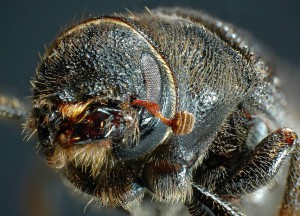![]() JBS Haldane famously remarked that the Creator appears to be inordinately fond of beetles – with over 400,000 species described, they make up over a quarter of all known animal species. This enthusiasm has not been shared by genomicists. Only a single beetle genome has been completed, that of the red flour beetle, Tribolium castaneum. Now, a new publication in Genome Biology DOUBLES our knowledge of beetle genomes, by describing the sequencing and assembly of the genome of the mountain pine beetle, Dendroctonus ponderosae.
JBS Haldane famously remarked that the Creator appears to be inordinately fond of beetles – with over 400,000 species described, they make up over a quarter of all known animal species. This enthusiasm has not been shared by genomicists. Only a single beetle genome has been completed, that of the red flour beetle, Tribolium castaneum. Now, a new publication in Genome Biology DOUBLES our knowledge of beetle genomes, by describing the sequencing and assembly of the genome of the mountain pine beetle, Dendroctonus ponderosae.
D. ponderosae is a species of bark beetle native to North America. The beetles lay eggs under the bark of various species of pine trees and then release pheromones to attract more beetles. When the eggs hatch, the larvae eat the wood. It is believed that a combination of beetle attack and a fungus spread by the beetles kills the trees.

Although it’s too late for the 15 million hectares of forest that the current outbreak has destroyed, it is hoped that this genome will lead to better methods for controlling the spread of this pest. It also will provide valuable genomic resources for comparing beetle biology. Two beetle genomes down, 399,998 to go.
Andrew Cosgrove
Latest posts by Andrew Cosgrove (see all)
- Exploring the history of smallpox vaccination with 19th Century American vaccination kits - 16th November 2020
- The fascination of plant genomes - 20th May 2019
- Genome Biology at Genome Informatics - 18th February 2019
Comments